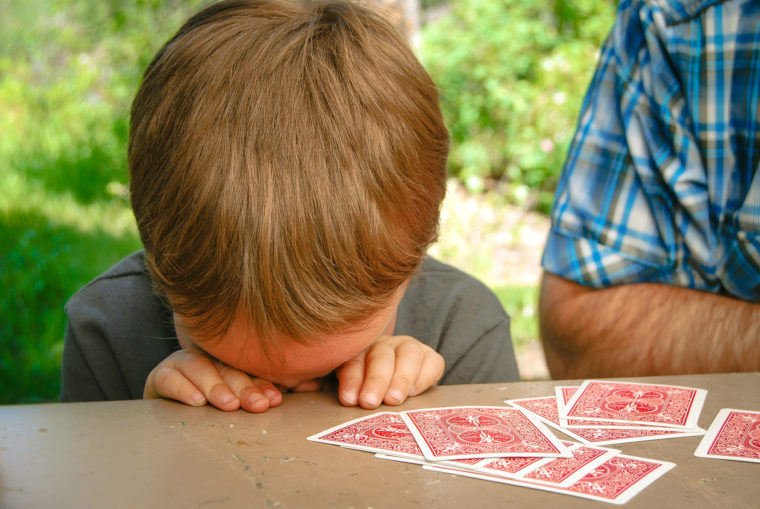Our parents, for the most part, didn’t listen to us while we were having passionate feelings. This had never been modeled for them. We, in turn, are sometimes at a loss as to what to say. We might manage not to interrupt our children’s intense feelings for awhile, but don’t have an easy time figuring out how to respond to their wants and stated needs.
Because Staylistening is a tool you use for many different kinds of big-blast emotional states—tantrums, grief, fear, even passionate anger with the desire to hit or bite—there’s no single formula to follow under these many circumstances. But here are some of the general things we’ve learned.
Your goal is to see what lets your child continue with emotional release, full and uninhibited, and to learn what slows her down or stops her. Sometimes, your child’s own fears will slow her down or stop her. You’ll need to see what you can do to set up fuller reassurance for her over time. But sometimes, a slightly off the mark comment will distract her from the feelings she’s trying hard to offload. This article may be helpful as you think of what to say to your child when she is offloading intense feelings. Don’t worry about perfection! These things take time to learn!
During Staylistening, you want to do at least 97% listening, with just a bit of talking here and there. If a child is wild with fear, go ahead and offer a steadier stream of verbal reassurance. Try to receive, understand, and take in every detail of the feeling your child is working through, and at the same time, let her know that you are guarding her, and that you’re confident she’ll come through it well.
Here are some of the things that are helpful to say.
1) You see what has happened and you care. Focus on your caring, and on the relationship. “I don't want to leave you all by yourself.” “I just want to be with you right now, nothing else.” “I know you wanted that cookie.” “Yes, Daddy went out the door; he loves you and he will be back.” “I know this is hard.” “I wish I could let you stay outside longer.” “Let me be with you for awhile here.” “I came as soon as I heard you call for me.” “I’m watching over you every minute.” (With arms held wide open) “I have room for you here in my lap.”
2) The present situation is safe. “I know she took your dolly. You can talk with her in a little while.” “Your brother doesn't mean to hurt you. I'm sorry I didn't get here sooner to help.” “Daddy will come back. He always comes back.” “It will stop hurting.” “Your body knows how to heal.” “You can have a cookie another day.” “No one is upset with you. But I do have to stop you.” “I think you can still have a good day.” “I’m not going to look for it right this minute. We might find it later.” “I know you want to go. But I think you might have a good time here.”
There’s a difference between saying “We might find it later,” with the intention of trying to stop the crying, and “We might find it later,” as a statement of fact, meant to indicate the overall safety of the situation. Try to stay on the side of indicating safety and hope, rather than distracting a child with the idea of hunting for the lost item.
3) It is safe to notice what just happened, or what is going to happen. “You really wanted the teacup she took.” “Let's look at your knee and see what happened.” “You can talk to him about grabbing the ball when you’re ready.” “That was too loud. I see.” “It's time for bed.” “It's time to say goodbye now.” “Are you ready to leave the park now?” You’re giving your child a break from having to do anything, and giving her permission and time to notice and show you how she feels. Gently touch on the exact thing that brought up the feelings. Refer to it only when the crying, tantrum or fear release slows down.
As long as your child needs to work on that particular chunk of emotion, every mention will bring fresh tears, tantrums or struggle. At some point, your child’s cascade of feelings will stop, and her mind will clear. Until then, touch on the sore spot occasionally, in a gentle but matter-of-fact way. Use the same tone you’d use to say, “The sky is blue,” to say, “Bruno has the blue bike.” “Serena got the last cookie.” “We're out of orange juice.” “It’s time to go now.” “The truck was in Buddy’s hands. It’s time to give it back.”
Pour some tenderness into your listening as you make these matter-of-fact statements, so that the truth of the moment is infused with your caring. This lets your child know that you think that life is basically on a good track, that you're not afraid of what happened, or what is about to happen, and that your attention is on her. When you’re not afraid, your child has room and safety to notice her feelings, offload them completely, and be done.
4) If your child is deep in the throes of fear, try to counter the feelings that are almost always coupled with fear. A terrified child will feel that she’s alone; that no one can help her; that she can’t figure things out; that this terrible thing will go on forever; that she might not survive; that she’s not smart enough, good enough or strong enough to survive; that no one else cares. Listen to what your child says and shows you, and offer reassurances that counter the aspect of fear or terror she tells you she’s experiencing.
“I’m right here, I won’t go away.” “I’m watching over you every minute.” “I’m right here to help you.” “You’re going to figure this out.” “You don’t know right now, but you will know. I am sure of it.” “This isn’t going to last forever. I’ll make sure of that.” “I know it’s hard, but it won’t always be hard.” “You made it.” “What frightened you is never going to happen again.” “You are good through and through. You are just right the way you are.” “You’re a strong, smart girl. I believe in you.” “Nothing can budge me from your side. I’m your Mom/Dad, and I am here to keep you safe.”
In general, children in the throes of fear need to hear that they will survive. Talking to them about our love, in these moments, is far less important. Survival is paramount. “You made it” and “I’m here” are key reassurances.
The things you say need to come from you, not from this list, but I hope this gives you some idea of the way a child’s feelings distort her reality, and the ways you can help her know that you love her and will anchor her while she is tossed by the feelings as she sheds them in this wonderfully healthy process.
Here are a few “don’ts” that we’ve identified over many years of listening to children in the throes of big feelings.
1) Try to avoid characterizing your child’s feelings. You want your child to tell you about her feelings. She gets to name her feelings, if she chooses to do so. For instance, we advise against saying, “Oh, honey, I see you’re so sad,” but we encourage you to say, “Oh, yes, that was hard,” so your child is left to have her feelings with whatever name she wants to give them, or no name for them at all.
Many people think that children need to be taught to name their feelings in order to mature, but we don’t agree. Your child will learn the names for her feelings without coaching from anyone. And asking a child to name a feeling often dampens the release of that feeling. It pulls your child’s attention back into the prefrontal cortex, and away from the limbic work of unloading emotional tension. Your listening is the key to this the process, not your child’s ability to name the feeling.
2) Try not to say things like, “I'll be with you until you calm down.” This directs the child’s attention toward ending the emotional release process. You can say, “I’ll stay with you while it’s hard,” or “I think you can still have some fun today,” or “I’ll see that you get some food you like today, but not cookies,” rather than “I’m going to stay here till your crying is done.” Talking about how the process will end leads your child to hurry the process, to get fixated on how much time has gone by, or to show you that she has “finished” crying, while obvious upset still clouds her mind.
3) Try to avoid talking about your conviction that it’s smart to cry or have a tantrum. “It’s good to get those feelings out, go ahead and be angry,” or other such comments, will make your child feel like there's a product you want from her. Over time, she will become self-conscious about the emotional release process. You want to help her feel your caring and your support instead. So when your child is sad, but there’s no physical fight she’s waging, stay close and simply let her feel the warmth of your presence and attention.
During an episode of work on anger or fear, in which a child may need to be physically active, we recommend saying something like “I’ll stay right here. You get to fight hard if you want. I won’t let you hurt me,” to give permission for a child to use you as a foil while she fights and cries in order to release feelings of fear. With this kind of “permission” comment, you’re talking about what’s going on between you and your child, rather than about the emotional release process. It’s the difference between pushing your child on the swings while you play an “I’m going to kiss you” game with him, and pushing him while you recite to him how many calories he’s burning while he’s pumping.
You can build your ability to be confident, warm and unshakable when your sweet child has been hurt, disappointed, or is facing a big and scary challenge. Here’s how you can use your Listening Partnership to steady your own emotional boat in heavy seas.
1) Pick the situations that worry you, anger you or pain you the most. Take them one by one as topics for your Listening Partnership turn. When you’ve chosen a situation, you can use the following approaches to allow you some relief from the grip of big feelings when they arise. These are not the only approaches: you and your Listening Partner will come up with what works best for you. These ideas are just to get you started!
2) Say all the things that come to mind to say, the ones that swirl in your head and that express your inner reaction. “Don’t you dare treat my child that way!” or “You fool! Why did you have to do that!” or “Poor baby! I don’t know what we’re going to do. I never wanted you to have to go through this!” Whatever your unvarnished response to the situation is, it needs to be heard by your Listening Partner.
3) Then, try to trace the feeling or the reaction you have back to your childhood. Is this what you never got to say to a domineering older sibling? To your own parents? Is this reaction full of heat because you were victimized in the same way? What did you need to say to people then? Did you need to scream for help? To beg your parents for protection? Explore, and go back in time to stand up for your young self, and to express the feelings that never were heard by a caring listener.
4) Try expressing yourself with more kindness, more tenderness and more complete attention than is comfortable for you. As you do, you’re likely to laugh with embarrassment, or with the feeling, “That’s not me!” Usually, our ability to express our love with our voices and faces and touch is limited by our parents’ modeling of kindness and full attention. Incomplete modeling of love and attentiveness tends to result in some stiffness on our part—it’s hard to feel at home giving a much rounder version of kindness than we ever got. So to expand your capacity to show the plentiful love you have, just try it out with your Listening Partner. Notice how you feel as you try. As you work to break the tight boundaries of the kindness shown to you, feelings will leap out, healing will take place, and you’ll notice changes in you that will be gratifying to you, and very helpful to your child.
For example, early in my own listening work, I decided I wanted to learn to show affection through touch. I had been able to be affectionate with my brothers and sisters growing up, but our parents were often too stressed to touch us with affection. I noticed that I wasn’t able to give or receive affection as well as I wanted. I spent many Listening Partnership hours doing the simple act of putting my attention on gently touching my Listening Partner’s hand, arm or cheek.
Doing this would flood me with tears, and a long stream of feelings flowed through me, hour by hour, that had to do with the illnesses that plagued our family, with the discipline that was meted out to us children, with my longings to make things better. Just putting attention on a simple sign of affection allowed lots of healing to take place, and my Listening Partner didn’t have to say a word.
Your ability to listen to your child will increase as you use Listening Partnerships as a place to try more tenderness, try more affection, and as an outlet for the emotions you had to tamp down in childhood. And the priceless inner sense that you’re giving your child exactly what she needs from you will increase, too. Your child’s confidence and trust in you will build, cry by passionate cry. And you will get to help her in a truly powerful way.
From the Hand in Hand Toolbox
- Want to get your parents on-board with Hand in Hand Parenting? Read this.
- Staylistening is one of Hand in Hand's Five Simple Tools. Read about the others here
- Help your child stop kicking, biting and other angry behaviors using science-backed tools. Get your free ebook here.



